
views
Personal Letter (United States)

Write the name of the recipient on the first line. The first line should contain the name of the person who will be receiving the letter. How you write the name depends on how they like to be addressed. If, for instance, you know your aunt prefers a certain level of anonymity, you could simply list her as "P. Jones," instead of "Polly Jones." Include any necessary titles. You can probably skip titles for close friends and family members, but you might consider including them for government officials, military personnel, doctors, professors, or elderly people. For instance, if you were addressing a letter to your elderly aunt Polly who was widowed many years ago, you might call her "Mrs. Polly Jones."

Place the letter in the care of someone else (optional). If you're sending someone a letter to an address where that person does not regularly reside, it might be wise to include a "care of" or "courtesy of" line below the name. Write "c/o" before the name of the person who does live there, the hotel, the hostel, etc. For instance, if your aunt Polly is staying with a cousin for a few weeks and you're sending her a letter there, you might write "c/o Henry Roth" below her name.
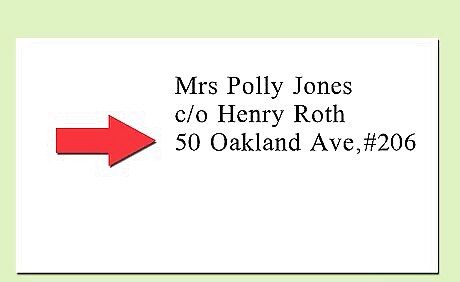
Write the street address or post office box number on the second line. If you're writing a street address, be sure to include any directional notation (such as "400 West" instead of simply "400") or apartment numbers. If the street address and apartment number are so long that they don't fit on one line, just write the apartment number on the line below the street address. For example, if your friend lives on 50 Oakland Avenue in apartment #206, write, "50 Oakland Ave, #206." You can use some abbreviations for the type of street it is, as long as you use them correctly. You can write blvd instead of boulevard, ctr instead of center, ct instead of court, dr instead of drive, ln instead of lane and so on. If you're addressing a letter using a PO box, there's no need to include the street address of the post office. Based on the ZIP code, the postal service will know where the PO box is.
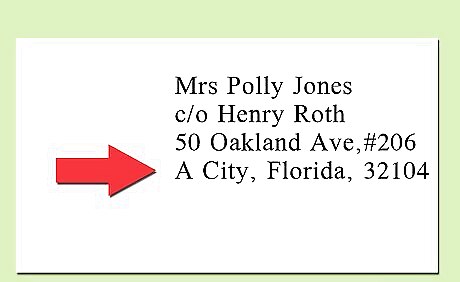
Write the city, state, and ZIP code on the third line. The state should be abbreviated with two letters, not spelled out. You can use a 9-digit ZIP code, though you don't have to. Five digits should be enough.
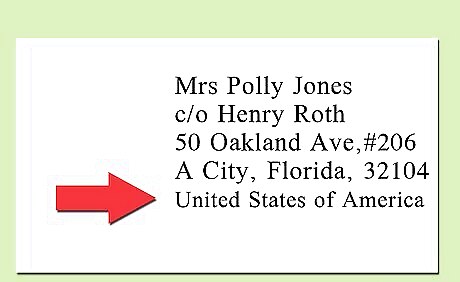
If you're mailing from another country, write "United States" on the address. If you're sending a letter from outside the US, you'll need to change your format slightly. Write the city and state on one line, "United States of America" on the line beneath that, and the ZIP code on the last line.
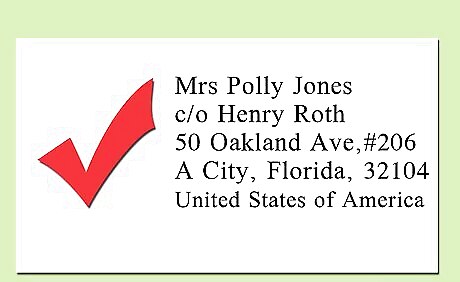
Finished.
Professional Letter (United States)

Write the name of the recipient. This could be a person or an organization, depending on where your letter is going. If possible, try to name a person as the recipient instead of listing an entire organization — your letter is more likely to get someone's attention that way. Make sure to use formal titles, such as "Mr.," "Ms.," "Dr.," or whatever the person's title may be. Write the recipient's position after their name (optional). For instance, if you're writing the director of marketing, you might say "Paul Smith, Director of Marketing" on the first line. Write "Attn:" followed by the person's name if the person occupies a single desk or office at an address, if you like. For example: "Attn: Shirley Shatten." If you're submitting your work to a journal and do not know who the fiction editor is, write, "Attn: Fiction Editor" to make sure your submission ends up in the right place.

Write the name of the organization on the second line. For instance, if you're writing to Paul Smith about a business matter and he works for Widgets, Inc., you'd write "Paul Smith" on the first line and "Widgets, Inc." on the second.

Write the street address or post office box number on the third line. If you're writing a street address, be sure to include any directional notation (such as "400 West" instead of simply "400") or suite numbers. If you're addressing a letter using a PO box, there's no need to include the street address of the post office. Based on the ZIP code, the postal service will know where the PO box is.

Write the city, state, and ZIP code on the third line. The state should be abbreviated with two letters instead of spelled out. You can use a 9-digit ZIP code, though you don't have to. Five digits should be enough.

Finished.
United Kingdom

Write the name of the recipient on the first line. Include any necessary titles. You can probably skip titles for close friends and family members, but you might consider including them for government officials, military personnel, doctors, professors, or elderly people. This could be a person or an organization.

Write the address number and name of the street on the second line. It's important that you write the number first and the street second. For example: 10 Downing St.

Name the town or city on the third line. For example: London.

Write the name of the county on the fourth line (if applicable). If, for instance, you're sending a letter to London, you probably don't need to write the county. But if you're sending a letter to a rural area, including it might be a good idea. If you know any other principal subdivisions, such as the province, state, or county, then include that as well.
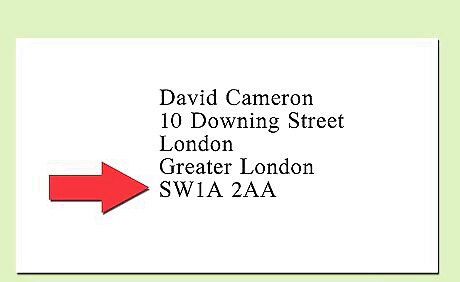
Write the postal code on the last line. For example: SWIA 2AA.
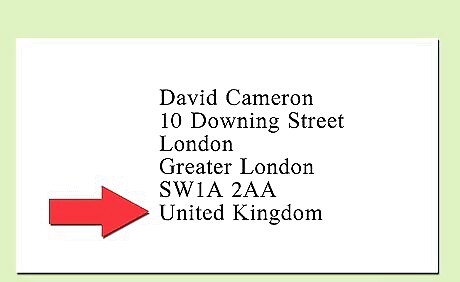
Include the name of the country (if applicable). If you're posting the letter from outside of Great Britain, write "UK" or "United Kingdom" on the last line.
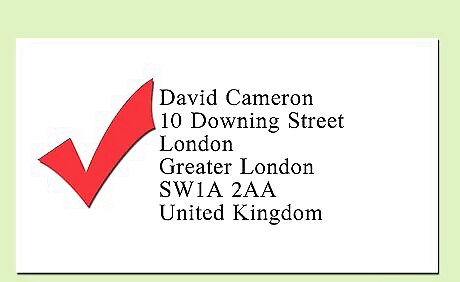
Finished.
Ireland

Write the name of the recipient on the first line. This could be a person or an organization. Include any necessary titles. You can probably skip titles for close friends and family members, but you might consider including them for government officials, military personnel, doctors, professors or elderly people.

Write the name of the house on the second line (if applicable). This is especially relevant in rural areas where houses or estates are known by name instead of by address. For example, you could write Trinity College Dublin.

Write the street on the third line. You can include the street number if you only have the street address. If you know the name of the estate, though, the street name alone should be enough. For example, College Green.

Write the name of the town or city on the fourth line. If you're sending a letter to Dublin, you'll need to follow the city name with a specific one- or two-digit postal code for that area of the city. You could write, Dublin 2.

Write the name of the county on the fifth line (if applicable). If you're sending a letter to a major city like Dublin, you probably don't need the county. If you're mailing to a rural area, though, you do. Note that in Ireland, the word "county" comes before the name, and is abbreviated "Co." So, for example, if you're sending a letter to County Cork, you'd write "Co. Cork" on the envelope.

Write the name of the country (if applicable). If you're mailing something to Ireland from outside of the country, write "Ireland" on the last line.

Finished.
France

Write the name of the recipient on the first line. Note that it is common to write a person's last name in all caps in France — for example, "Mme. Marie-Louise BONAPARTE." Include any necessary titles. You can probably skip titles for close friends and family members, but you might consider including them for government officials, military personnel, doctors, professors or elderly people.

Write the name of the house or estate on the second line. This is especially relevant in rural areas where houses or estates are known by name. You could write, for example, Chateau de Versailles.
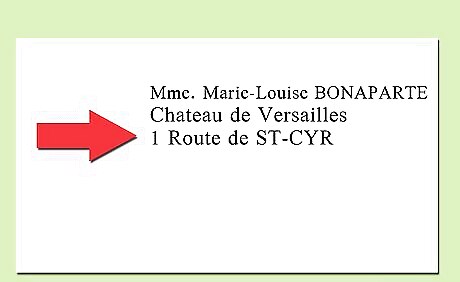
Write the street number and name on the third line. The street name should be in all caps. For example, you might write "1 ROUTE de ST-CYR."

Write the postal code and city name on the fourth line. For example, 78000 Versailles.
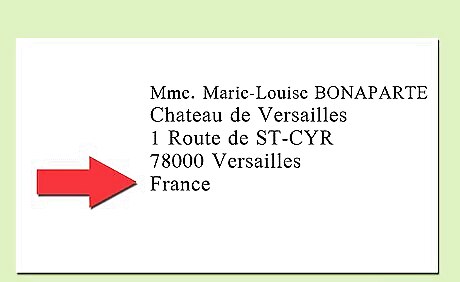
Write the country name on the fifth line (if applicable). If you're mailing between countries, include "France" on the last line.
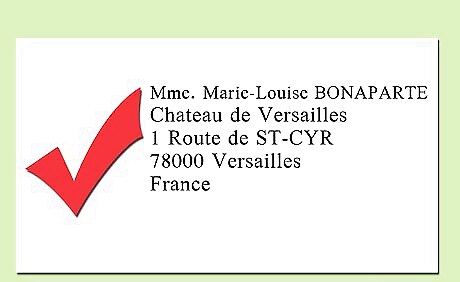
Finished.
Most of Europe

Write the name of the recipient on the first line. This could be a person or an organization. Include any necessary titles. You can probably skip titles for close friends and family members, but you might consider including them for government officials, military personnel, doctors, professors or elderly people.

Write the name of the house on the second line (if applicable). This is especially relevant in rural areas where houses or estates are known by name instead of by address.

Write the street name and number on the third line. For example, you might write "Neuschwansteinstraße 20."
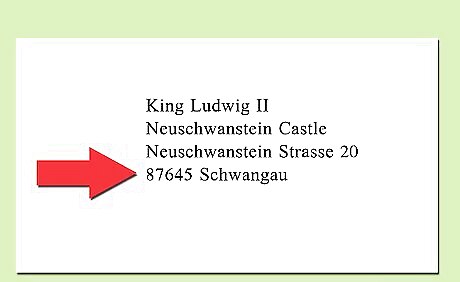
Write the postal code, city and initials of the province (if applicable) on the fourth line. For example, "87645 Schwangau."
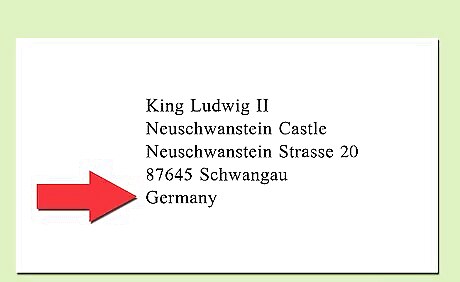
Write the country on the fifth line (if applicable). If you're mailing between countries, include the name of the country on the last line.

Finished.

















Comments
0 comment